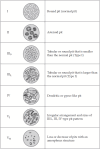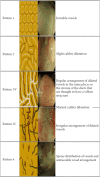Classification of image-enhanced endoscopy in colon tumors
- PMID: 40336268
- PMCID: PMC12138368
- DOI: 10.5946/ce.2024.263
Classification of image-enhanced endoscopy in colon tumors
Abstract
Colorectal cancer accounts for 10% of global cancer cases in each year, making accurate evaluation and resection crucial. Imaging-enhanced endoscopy helps differentiate between hyperplastic polyps and adenomas, guiding treatment decisions. Colon tumors are classified into benign (e.g., serrated and adenomatous polyps) and malignant (e.g., adenocarcinomas). The Paris classification categorizes superficial neoplastic lesions by morphology, while laterally spreading tumors are classified by size and growth pattern. Effective classification aids in determining resectability and appropriate interventions for colon tumors, ultimately improving patient outcomes. Image-enhanced endoscopy improves colon tumor diagnosis using various techniques like dye, optical, and electronic methods. Kudo's pit pattern categorizes lesions based on surface morphology using dye, while Sano, Jikei, and Hiroshima classifications focus on vascular patterns using narrow-band imaging (NBI). The NBI International Colorectal Endoscopic (NICE) classification integrates these methods to identify lesions, especially deep submucosal invasive cancers. The Workgroup Serrated Polyps and Polyposis (WASP) classification targets sessile serrated lesions, and the Japan NBI Expert Team (JNET) classification further refines adenoma categorization with low- and high-grade adenoma. The Colorectal Neoplasia Endoscopic Classification to Choose the Treatment (CONECCT) classification consolidates multiple systems for comprehensive assessment, aiding in treatment decisions and potentially applicable to artificial intelligence for diagnostic validation across imaging modalities like linked color imaging, blue light imaging, or i-scan.
Keywords: Adenomatous polyps; Colonic polyps; Colorectal neoplasms; Endoscopy; Narrow band imaging.
Conflict of interest statement
The author has no potential conflicts of interest.
Figures














References
-
- Dudás B. Human histology: a text and atlas for physicians and scientists. Elsevier; 2023.
-
- Kumar V, Abbas MBBS AK, Aster JC. Robbins and cotran pathologic basis of disease. 10th ed. Elsevier; 2021.
-
- Lamps LW, Bellizzi AM, Frankel WL, et al. Neoplastic gastrointestinal pathology: an illustrated guide. Demos Medical Publishing; 2016.
Publication types
LinkOut - more resources
Full Text Sources

